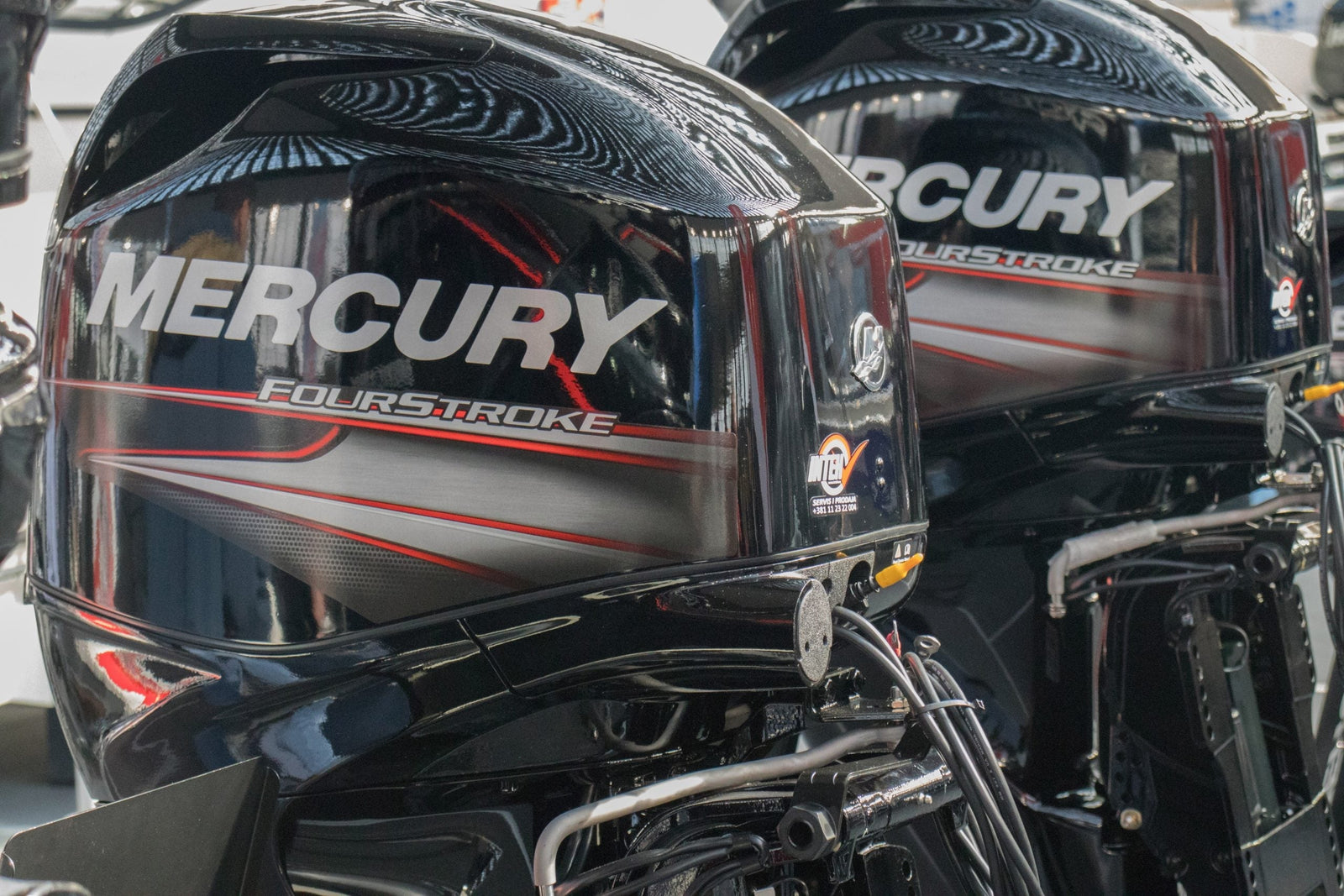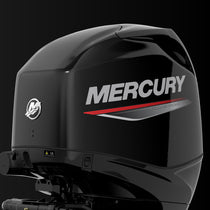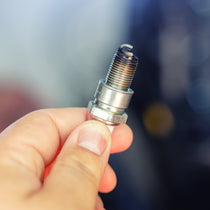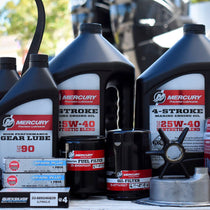If you're wondering how many hours a boat motor lasts or how to check hours on a Mercury boat motor, you're not alone. Engine hours play a crucial role in maintenance schedules, resale value, and overall engine health. Whether you're buying a used boat or simply tracking service intervals, this guide explains how to check engine hours, how boat engine hours are calculated, and what factors impact the lifespan of an outboard motor.
There are three ways to check hours on a Mercury Outboard—engine diagnostics, a gauge on the boat's console, or an after-market engine hour meter. Some boaters rely on the old-school method of pen and paper logging. We believe manual logging has a lot of value, but today is best coupled with electronic methods.
As we will explore below, hours reported from the engine’s diagnostics system are by far the most reliable, and later model Mercury outboards deliver engine usage information well beyond just hours operated.
A Bit of Mercury Outboard History

In 1987, Mercury first introduced electronic controls—essentially a computer brain—by debuting electronic fuel-injected (EFI) outboards. So, for well over three decades, at least rudimentary engine information, like hours operated, can be accessed by Mercury dealers will the proper diagnostics system.
We say rudimentary engine information because while the electronic controls introduced in 1987 were quite remarkable for the times, technology has come a long way.
In 1996, Mercury further advanced electronic control with its direct-injection OptiMax. The direct fuel injection (DFI) technology helped Mercury meet the new EPA emissions requirements. OptiMax featured a unique air-assist injection system that employed an air compressor and a lower-pressure fuel injector rather than a high-pressure liquid pump.
Since these two marine industry-leading breakthroughs in 1987 and 1996, Mercury marine's electronic controls have continued to advance and have become increasingly sophisticated over the years.
How Do You Check the Hours on an Outboard Motor?
To check hours on a Mercury boat motor, use the engine diagnostics system, console gauge, or an aftermarket hour meter. For the most accurate reading, visit a Mercury dealer, who can retrieve exact engine hours and runtime history using diagnostics software.
Use Engine Diagnostics (Most Accurate Method)
- Visit a Mercury outboard dealer to access the onboard diagnostics system.
- Dealers use Mercury's proprietary software to pull exact engine hours.
- This report includes detailed runtime history and service alerts.
Check the Boat Console Display
- Some boats have SmartCraft gauges that accurately track engine runtime.
- However, older analog hour meters might track hours even when the engine isn’t running.
Use an Aftermarket Hour Meter
- Installed by wrapping wires around the spark plug.
- Logs actual engine runtime instead of just key-on hours.
- Best for maintenance tracking, but not reliable for resale evaluation.
Engine Diagnostics
To access a Mercury outboard's computer memory, you will need to visit an authorized Mercury outboard dealer. The dealer will have the necessary computer software and the cable to plug the shop's laptop into your outboard.
A dealer might charge you for 30 minutes or so of labor to run a diagnostic scan, but if you are buying a used Mercury outboard, this investment is well worth it. However, if you are negotiating to buy the motor from a dealer, the dealer should be glad to give you a diagnostics report for no charge.
Console Display

While rigging for all outboards has become more and more sophisticated, including Mercury outboard rigging, there are some points of caution. If correctly installed, Mercury's newer SmartCraft gauges will tap into the outboard's computer and display the correct hours even if you change the gauges. Because these advanced gauges are tapping the engine's computer, the hours displayed will reflect the hours the engine was actually running versus hours when the key was merely in the "on" or "accessory" position.
A console's hour meter runs from the voltage that is supplied to it. This voltage comes from the key switch, which meant that older gauges often tracked engine hours when the key switch was merely on, whether or not the engine was running.
Depending on the gauge in use, hours spent in the swimming hole or at the dock listening to the boat's stereo might be reflected within the console’s hour display. Therefore, depending on how you use your boat, the hours displayed within your console’s hour meter display might become quite inflated. This inflated report might lead you to perform maintenance more often than needed, and if this data is used when it comes time to sell your boat, you may be selling yourself very short.
On the flip side, if you are considering buying a used boat or a used engine based on hours displayed on the boat’s console, you could be deciding with wildly inaccurate data. If the boat’s owner replaced the gauges at any point during the engine’s life, the hours were likely reset to zero.
Also, if the boat owner has an analog hour meter on the boat’s console, a dishonest seller can easily wind back the hour meter.
After-Market Engine Hour Meter
While we don’t recommend using data from after-market engine hour meters to make used engine buying decisions, these meters are quite helpful for tracking engine operating hours for maintenance interval purposes. Additionally, they are great for small fishing boats and skiffs that don't have console gauges.
When installing an engine hour meter, the engine hour meter's wiring is wrapped around the spark plug wires. Therefore, the meter logs when the engine is actually firing rather than the number of hours the meter itself is receiving voltage.
Additionally, many after-market engine hour meters are multifunctional and allow you to track various data and include some valuable features like a maximum RPM alarm, low voltage alarm, battery voltage, etc.
While engine hour meters are inexpensive and handy tools for maintaining your engine, their information is not dependable for making a used engine buying decision. The reason is that the meter only reports data from the time it was installed—if the meter was installed when the engine was ten years old, or if it was recently replaced—the data will not be accurate.
How Long Do Boat Motors Last? Mercury Outboard Lifespan Explained
A well-maintained Mercury outboard typically lasts 3,000 – 4,000 hours, but some engines exceed 6,000+ hours. Factors like maintenance, operating conditions, and usage patterns significantly impact longevity. Regular service, proper storage, and using high-quality fuel extend engine life.
How Many Hours Will a 4-Stroke Outboard Last?
Why all of the discussion about Mercury outboard engine hours? The question of how many hours a Mercury outboard is expected to last is at the heart of the matter. Whether you are trying to plan how long before you probably have to buy a new outboard or working to determine the fair value for either a used outboard you are selling or considering purchasing, projecting how long engines last is critical.
The question of how long a Mercury outboard will last includes a lot of "it depends." The reality is, a well-maintained Mercury outboard will last a long, long time. Also, even with proper maintenance, some types of engine usage are just harder on the engine. For example, if a Mercury outboard experiences long periods of wide-open throttle, extended periods of trolling, or load weight is commonly higher than recommended, service intervals need to be more frequent, and overall engine life will likely be shorter.
So, with a significant number of caveats, we’ll say that it is typical for a well-maintained Mercury outboard to last for about 3,000 – 4,000 hours of operation. But, as stated, there are so many factors influencing engine life.
Mercury outboards are extremely well-engineered engines, and we have seen many with 6,000 and even 12,000 hours on them still performing exceptionally well.
How Are Boat Engine Hours Calculated? Why Age Matters
While engine hours are typically the most widely considered metric when discussing likely remaining life, the age of the engine is also an essential factor that can be overlooked. A 25-year-old engine with only 300 hours of operation might, at first glance, sound great. However, how was the engine stored, and was the engine maintained over its life? A dormant engine improperly stored will be worth very, very little even though it has very few hours on it.
Late-Model Mercury Outboard Engine Reporting Advancements

The electronic engine controls of later model Mercury outboards contain much more comprehensive information. For example, most later-model Mercury outboards record every instance that the motor generated a warning alarm or a fault code. These warnings include over-revving the engine, over-heating, and over-charging the battery. Frequent instances of over-revving could indicate an abusive owner or one who's been using an improper prop. In either case, the engine experienced much more wear and tear than typical usage.
The engine run time history report a Mercury dealer can generate using their diagnostics equipment and software will include a breakdown of hours in 1000-rpm increments from idle to the engine's max rpm.
This history gives you an idea of how the motor was actually used. A typical usage pattern should show about 40 percent of the hours below 1000 rpm. However, an engine that was never run at higher rpm is quite odd and should cause a significant pause for questioning.
Important Takeaways
The question of how do I check my outboard's hours and why these hours should be checked and monitored is quite important.
If you are buying or selling a used Mercury Outboard
A Mercury dealer should generate an engine run time history report. The dealer will access this information by plugging into the engine's electronic control system—the more recent the engine's model year, the more comprehensive the available data.
This report is the only reliable window into the number of hours on the engine and the conditions under which it was operated.
Monitoring your engine for maintenance interval purposes
The hours operated data on your boat's console is beneficial, but depending on how advanced your gauges are, not necessarily incredibly accurate to log the number of hours the engine was actually running. Given that console gauges are powered by the voltage, older console gauges might over-represent the engine's hours in operation. If you have an older engine and older or analog gauges, engine hour gauges installed by wrapping its wires around spark plug wires are often much more accurate for logging your engine's actual operating hours.
While very useful for logging hours for maintenance purposes, data from after-market gauges should not be relied upon to make used outboard engine buying and selling decisions.
Whether it is after-market engine hours meters, Mercury service kits, or other products, shop for your boat parts with PartsVu!





















25 comments
I just purchased a pontoon with a 90 horse mercury two stroke optimax. What should I look for and check on? Greatly appreciated for any help. Older folks owned. Well maintained.
Engine hours → Verify through a dealer or diagnostic tool, since hours give you a good idea of wear. * Compression test → Ensures cylinders are healthy and balanced. * Fuel system → Inspect fuel lines, primer bulb, and filters (especially if it’s been sitting). * Lower unit → Check gear oil for water intrusion or metal shavings. * Propeller & seals → Make sure the prop is in good condition and seals aren’t leaking. * Cooling system → Confirm the water pump impeller has been serviced recently. * Batteries & electrical → Inspect wiring, charging system, and connections. Since it sounds like it’s been well maintained, you should be in good shape, but a routine service and inspection can give you peace of mind before putting hours on the water. If you’d like, our team can also help track down the owner’s manual, maintenance parts, and schematics for your Optimax. Please feel free to give us a call or send a request to partsvu@partsvu.com — we’ll be happy to help!———
PartsVu replied:
Hi Mike, congratulations on the new pontoon! With a 90HP Mercury 2-Stroke Optimax, here are a few key things to look for and check on:
Best Regards Markine
Is there a hr meter on a 2017 merk 75hp 4-stroke
1. SmartCraft Gauges: If your boat is equipped with SmartCraft or VesselView gauges, you can access engine hours directly from the display. 2. Diagnostic Tool: A Mercury dealer or mechanic can connect a diagnostic computer to read the engine hours. 3. Add-on Hour Meter: If you want a visible hour meter on your dash, you can install an aftermarket or Mercury SmartCraft hour meter kit.———
PartsVu replied:
Hi, The 2017 Mercury 75 HP 4-stroke outboard does not come with a traditional hour meter built into the gauge panel unless it was added as an accessory. However, the engine’s ECU (Engine Control Unit) does track total running hours internally. You can check engine hours in the following ways:
Best Regards Markine
How do I get the engine hours on my 2012 Ranger 520Z Comanche using the gauge on the dash with the mode indicator
———
PartsVu replied:
Hi Rich,
Great question! To check the engine hours on your 2012 Ranger 520Z Comanche using the Mercury SmartCraft gauge (with the Mode button), follow these steps:
1. Turn the key to the ON position (engine does not need to be running). 2. On your gauge, press the “MODE” button repeatedly until you see the “ENGINE HOURS” display. 3. If you pass it, just keep pressing MODE again—the display cycles through various readouts. If your gauge isn’t a SmartCraft model or doesn’t show engine hours, you may need a dealer to check with a diagnostic tool, or you could connect a SmartCraft VesselView Mobile device for easy tracking through your phone. Let us know if you have any other questions—we’re happy to help!Best regards, Markine
[…] PartsVu Xchange […]
Hello Kent,
Thank you for contacting us.
For a 2010 Mercury 150 Optimax 2-stroke engine, there are several methods to determine the engine hours:
SmartCraft Instrumentation: If your boat is equipped with Mercury’s SmartCraft gauges, the engine hours can be easily viewed on the display. SmartCraft is Mercury’s digital technology that connects the engine to customizable digital displays on your boat’s dashboard. If you have these gauges, you can navigate through the menus to find the engine’s total hours.
Mercury VesselView Mobile: Mercury offers a device called VesselView Mobile that connects your engine to your smartphone. Once connected, you can view various engine data, including the total engine hours, via an app on your phone. This device connects to the engine’s computer and reads data directly from it.
Mercury Dealer or Marine Mechanic: If you don’t have SmartCraft gauges or the VesselView Mobile device, the simplest way to find out the engine hours is to take the boat to a Mercury dealer or a marine mechanic. They have diagnostic tools that can be connected to the engine’s Electronic Control Unit (ECU) to read the total hours and other engine data.
Best,
Mario